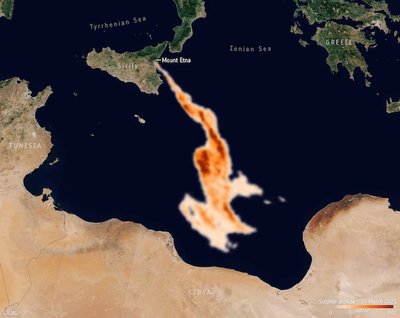Summary
Stratospheric aerosols, formed primarily from sulphur dioxide (SO₂) released during volcanic eruptions, influence the amount of energy entering and leaving the atmosphere - and therefore Earth's climate. Climate models rely on accurate representations of such climate forcings to reliably simulate past climate variations and predict future climate behaviour.
This project aims to provide stratospheric aerosol forcing for the next generation of climate model simulations (via CMIP) and to quantify uncertainties in this forcing. To make progress on previous datasets, the project will address two challenges. Firstly it will provide a dataset for volcanic sulphur emissions suited to state-of-the-art models need to interactively simulate stratospheric aerosols from precursor emissions. Secondly, the project will attempt to fill the gaps in small but frequent eruptions that were mostly unaccounted for over the pre-satellite era (prior to 1979) in predecessor datasets.
Project Background
The coupled model intercomparison project (CMIP) is a set of coordinated climate model simulations run by dozens of climate modelling centres worldwide. These simulations underpin our understanding and attribution of past climate change, and projections of the future. These models form key lines of evidence as part of United Nations Intergovernmental Panel on Climate Change (IPCC) assessment reports and in turn underpin national and international climate policies. One of the key simulations run used the so-called historical simulation which starts shortly after the onset of industrial revolution, 1850, and run until present day. Historical simulations are key to evaluate climate models against climate observations and in turn gain confidence in their capability to predict the future, and they are also critical to understanding the role of natural and anthropogenic drivers, also called forcings, of historical climate change.
Volcanoes - a natural driver of climate change
One of the most important natural drivers of climate change is stratospheric aerosol, primarily formed from sulphur gases injected into the stratosphere by powerful volcanic eruptions. These aerosol particles can reside a couple years in the stratosphere and spread globally. Their main effect is to reflect a small fraction of incoming Sun radiation, thus resulting in a cooling of Earth surface.
To provide stratospheric aerosol forcing inputs to climate modelling centers for 1850-present day, a key challenge is that there is no direct observation of stratospheric aerosol prior the onset of the satellite era, around 1979. Before that time-period, we typically rely on volcanic aerosol forcing models which take as input the amount of sulphur gases erupted by volcanoes reconstructed from ice-core measurement. Ice-cores are our main archive to reconstruct past atmospheric composition, and some of the stratospheric volcanic aerosols are deposited at the poles, in the ice, recording past volcanic events.
Scientific challenges addressed by the project:
- Determining the exact characteristic of past volcanic injections (e.g. mass and latitude) based mostly on information on sulphate deposited in ice-cores before 1979, and on satellite measurements after.
- Filling gaps in small-magnitude but frequent volcanic eruptions. These eruptions are largely undetected in most ice-core datasets, but they contribute up to 50% of long-term volcanic injections into the stratosphere.
- Improving volcanic aerosol models used to translate volcanic sulphur injections into stratospheric aerosol forcing
- Combining our model-derived, 1850-1978 dataset with direct satellite observations from 1979 onwards.
To address these challenges, the project team is highly interdisciplinary, including ice-core experts, satellite experts, aerosol modellers, climate modellers, and volcanologists
Project aims and objectives
The overarching project objective is to provide stratospheric aerosol optical properties and volcanic stratospheric sulphur emission datasets for phase 7 of the Coupled Model Intercomparison Project (CMIP7).
The first task of the project is to deliver the 1750-present day volcanic forcing dataset. To achieve this, key steps are to:
- Collate state-of-the-art ice-core and satellite records of volcanic sulfur injections and stratospheric aerosols.
- Combine ice-core sulfur injection records with volcanological records to best constrain volcanic sulfur injection parameters
- Fix biases in small-magnitude eruptions under-recorded in ice-core records
- Develop a volcanic aerosol model capturing well how volcanic sulfur injection translate in terms of stratospheric aerosol perturbations.
- Produce a consistent dataset combining the pre-satellite and satellite era information.
Once this first objective is achieved, two critical objectives are to extensively document the dataset to facilitate its use by scientists, and to facilitate operationalisation of volcanic forcing production, i.e. regular updates and improvements to this dataset in the future.
Secondly, reconstructions of past volcanic forcing are characterized by large uncertainties. Accordingly, our second set of tasks is:
- Create uncertainty products associated with our main dataset
- Quantify how volcanic uncertainty propagate in terms of simulated historical climate, and implications for evaluating climate models as well as attributing past climate change.
The Science leader of the Volcanic forcing for CMIP project is Prof Thomas Aubry of the University of Oxford.
Partners include:
- Anja Schmidt (German Aerospace Agency)
- Mahesh Kovilakam (NASA)
- Matthew Toohey (University of Saskatoon)
- Sujan Khanal (University of Saskatoon)
- Michael Sigl (University of Bern)
- Man Mei Chim (University of Exeter)
- Ben Johnson (UK Met Office)
- Simon Carn (Michigan Technological University)
- Magali Verkerk (University of Exeter)
- Zebedee Nicholls (Climate Resource)
- Isabel Smith (University of Exeter)
Science Leader: Prof Thomas Aubry
ESA climate applications scientist: Dr Claire Macintosh
Latest news & events

CCI colocation & CMUG integration meeting 2026
Annual gathering of the CCI community for ESA programme updates, scientific progress, and forward-looking discussions.
Mehr erfahren
New Position: Junior Professional in AI for Climate Science
Opportunity for early-career Artificial Intelligence talent to join ESA’s Actionable Climate Information Section
Mehr erfahren

